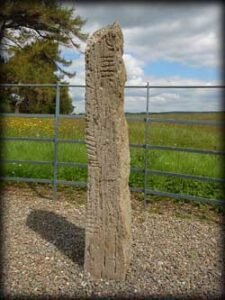What is Ogham and How Was it Used in Ireland?
It was inevitable that as languages evolved in early human settlement, communities would eventually came to the conclusion that it would be useful to record matters of importance. Those residing in Early Medieval Ireland were centuries away from transcribing on vellum (animal skin) or other types of parchment, and so used what they did have plenty of: stones. From this, the fascinating ancient alphabet of ogham was born.
Recording inscriptions in primitive Irish, ogham is often nicknamed the “Celtic Tree Alphabet,” perhaps both because the shape of the letters and because early literature has ascribed a tree to each of them. Due to its inventiveness and unknown origins, ogham continues to attract scholarly attention and speculation.
When was Ogham Used?

It is difficult to date ogham stones, especially since very few names written in the script have been linked to known figures in history. Instead, researchers study the linguistic developments in the early Irish language to estimate when the inscriptions were created. This puts most surviving examples of ogham between the 5th and 7th century AD.
Currently, most scholars, using the assumption that ogham was based on the Latin alphabet, refer to the alphabet’s similarity to the recorded teachings of Donatus, a 4th century grammarian. James Carney, a noted Medieval Irish language researcher, instead points to early linguistic similarities with the Roman language and insists that Ogham was likely created one century BCE.
Why was It Invented?
There are competing theories on the motivation behind using Ogham. Some scholars suggest that it was a cryptic language employed by those native to the island. During the time which early examples of the letters appear, southern Britain was ruled by Roman authorities. Those in Ancient Ireland were concerned over the threat of invasion, and so it was postured that ogham allowed the religious and political rulers a way to secretly communicate.
A second popular opinion is that the script was created by the first Christians in Ireland, on account that the sounds in primitive Irish were difficult to capture in the Latin alphabet. The earliest known Christian settlements correspond on the same timeline as the oldest surviving ogham stones.
Due to the nature of its letters and the medium being used, inscriptions were short by necessity. Most examples denote a person’s name, causing some scholars previously think that it was used largely for grave markers. However, its lack of prevalence at known burial sites now suggests that ogham stones marked the boundaries of property or were monuments to celebrated heroes.
How Does Ogham Work?

The twenty letters, or feda, in ogham are separated into four groups (aicmí) based on the direction and position of strokes. For example, the B, or beith group of letters (BLFSN) all consist of a stroke to the right of the stem line, with one stroke indicating “B,” two for “L” and so on. Later, an additional group of 5 letters were added to the script, called the forfeda.
Ogham is unique in that it is read bottom to top. Because the script was often written on angled stone—the corner of the stone being used as the stem line—it is essentially a 3D alphabet. Of interesting note, originally there was no letter for “P”, as the sound wasn’t used in the earliest Celtic languages.
Where can Ogham be Found Today?
Presently, over 400 surviving ogham stones have been found, with approximately 360 of them located in Ireland. Within Ireland, most have been discovered in Cork, Kerry and Waterford, with over 60 examples on the Dingle Peninsula alone. Stones outside of Ireland include Wales, Southeast England, Scotland and the Isle of Man.
Recently, the Discovery Programme has mapped most discovered ogham stones in Ireland and the UK. The Discovery Programme is a national archeological research body supported by the Heritage Council in Ireland.
While there is still much to learn about the ancient script, the use of ogham examples yet another component of Ireland’s rich historical and cultural links to language. It is fascinating to trace how the Irish language developed along with the Irish people, and the importance it has held for them. Rarely can one find a place with such an intimate relationship between language and identity.
(Photo: Stephen Trew/flickr.com/CC-BY SA 2.0)
Join the online Irish community for cúrsaí, comhrá & ceardlanna, and follow along on social media @LetsLearnIrish – beidh fáilte romhat!





